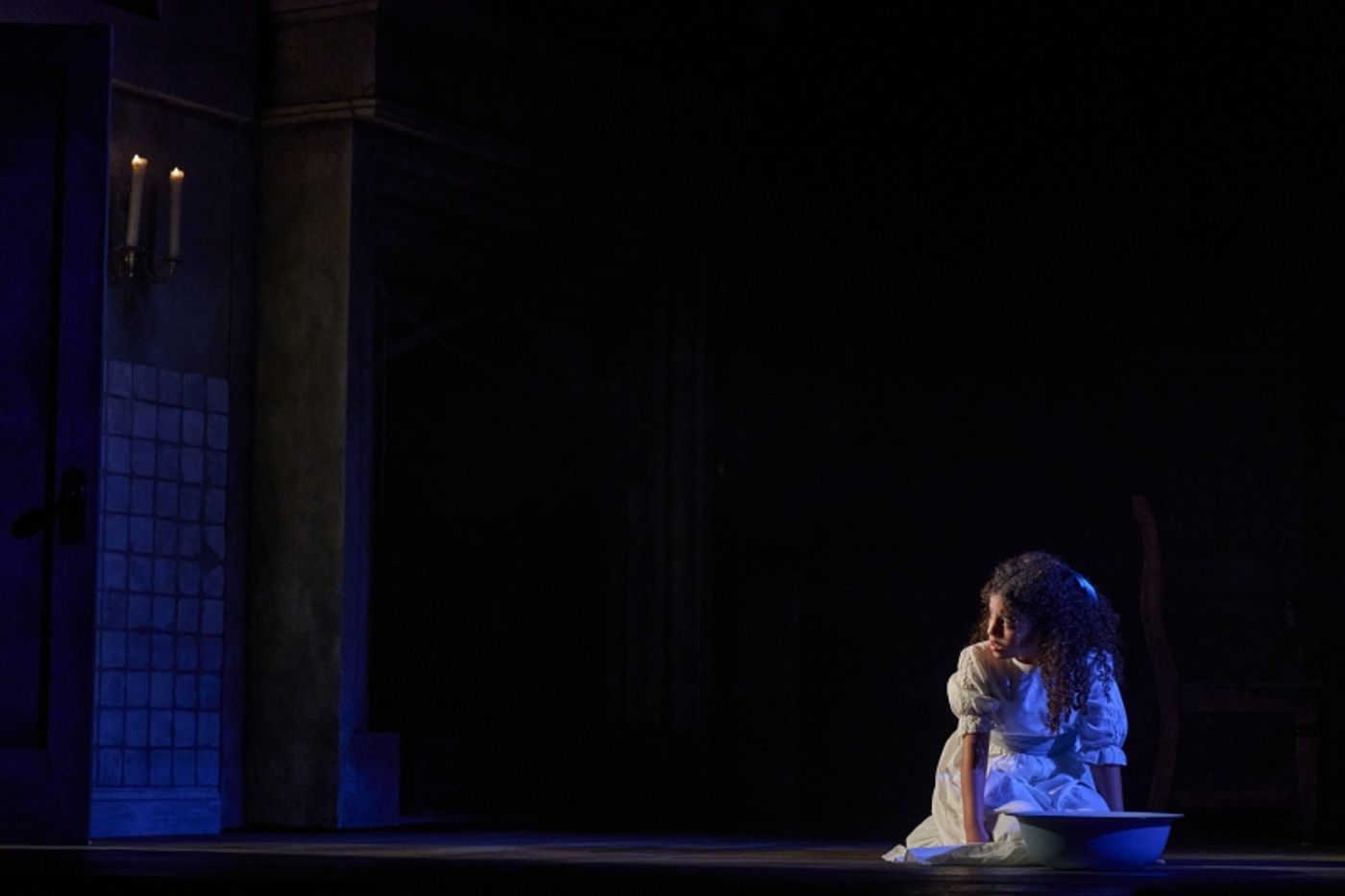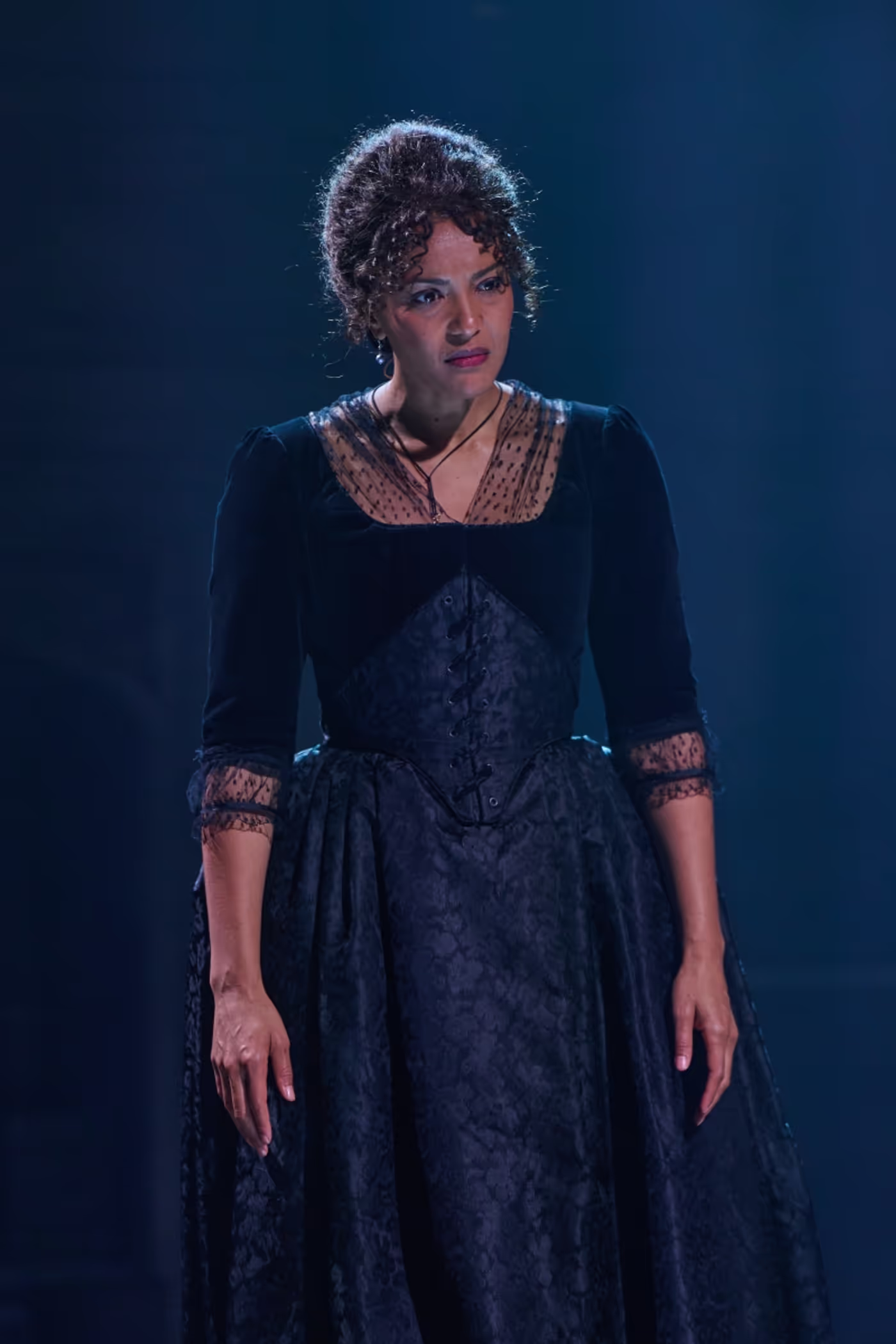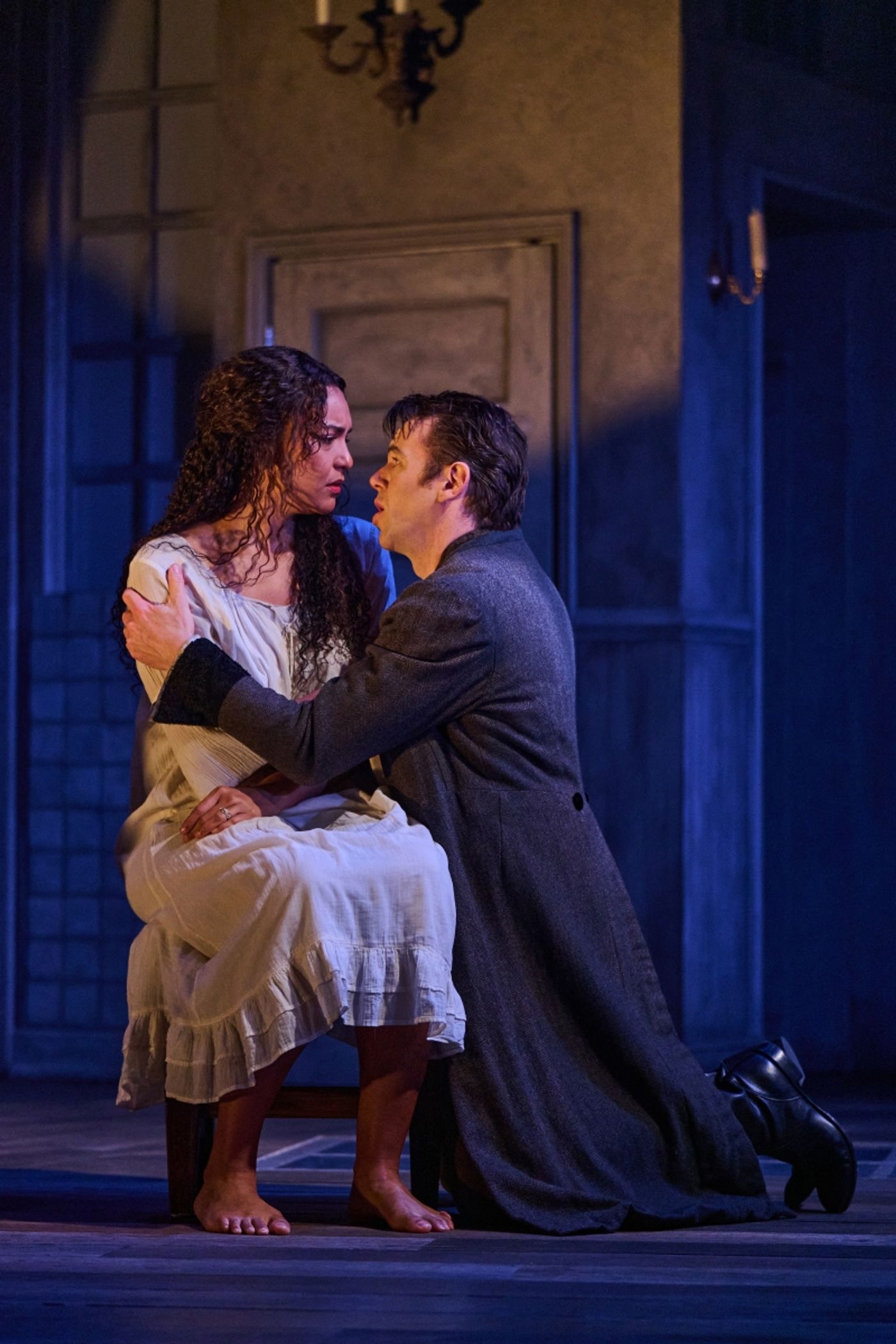Review: FRANKENSTEIN at Shakespeare Theatre Company
Shakespeare Theatre Company’s latest production, written and directed by Emily Burns, opts for a new angle.

In 1816, during a stormy summer at Lord Byron’s estate in Geneva, a ghost-writing competition led to the first drafts of the seminal work, Frankenstein; or, the Modern Prometheus, written by a 16-year-old Mary Shelly. Since its publication in 1818 (and the revised version, which is more widely read, in 1830), Frankenstein has captured the imaginations of generations around the world, generating plays, films, and retellings throughout the centuries, and Shelly’s work is often regarded as the birth of science fiction.
The story is well-known, but it continues to draw audiences, fascinated by discussions of the scientist, Victor Frankenstein, his quest to harness the ability to create life itself, his rejection of his creation, and the subsequent violent reckoning. The tale has been used to examine hubris, parenthood, free will, faith, and so much more, giving insight on humanity and how each reader and society define it. Central to the story is the fundamental question: what makes a monster? While Victor, the main narrator, persists in calling his Creature one, it never seems that Shelly felt that way; there’s a compassion for the creature, who is spurned from his inception and only grows with the later intervention of a kind family that takes him in, and a clear sense that she views the man who created and abandoned this new life as the true villain (an interpretation supported by the fact that the first version of the novel was completed while a pregnant Shelly was abandoned by her husband and struggling with the suicides of both her half-sister and sister-in-law).
With such a powerful universal message and an impressive endurance, Frankenstein has been reinterpreted in various mediums over the years, but these retellings always hit the same key beats: Victor’s research and rejection, the Creature’s found family and his renewed quest for revenge when he understands exactly what Victor’s callous dismissal has denied him, and a lifetime locked in a conflict that can only end in mutual destruction. There are countless interpretations that follow this sequence, but Shakespeare Theatre Company’s latest production, written and directed by Emily Burns, opts for a new angle.

Trusting that the audience is already familiar with the story – as well as the well-trodden “he’s alive” sequences with the lightning and maniacal laughter that are ubiquitous in modern pop culture – Burns’ script instead examines something often forgotten, and indeed disregarded by Victor himself: the consequences of Victor’s actions. Not, notably, just in relation to the Creature’s rejection and violent responses, but the consequences on other aspects and people in his life. Burns shifts the focus entirely to the Frankenstein family home in Geneva – we never see Victor’s work in Ingolstadt or his confrontations with the Creature or the mad chase through the Arctic. Just a family, thrown into turmoil by loss and an ever-growing web of lies.
At the heart of Burns’ version is not Victor, but Elizabeth, his adopted sister and fiancée. Elizabeth, who stayed behind when Victor left for Ingolstadt to help the family heal following their mother’s death, who watched the little brother she raised meet a violent end due to Victor’s mishandling of the Creature’s grievances, whose servant and companion shouldered the blame because Victor refused to intervene until he thought it might benefit him, whose life remained on hold while Victor pursued his passions and put his own interests above hers at every possible turn.
In the original novel and most retellings, the Creature takes his revenge on Victor for refusing to create him a companion by killing Elizabeth on her and Victor’s wedding night – her death is often portrayed as a way of leveling Victor and his Creature, so that they are both wholly alone in the world, apart from each other and the revenge they seek. In Burns’ interpretation, though, Elizabeth insists on marriage before Victor departs for Ingolstadt again, and lives to give birth to their daughter before Victor insists they leave the ailing baby behind to flee the Creature – though he fabricates a tale rather than telling her so. Elizabeth’s survival in this retelling is in some ways even more devastating, because she lives to understand the depths of Victor’s betrayal and selfishness, and, while he fails to face the consequences of his actions, she sees them all too clearly. At the long-awaited confrontation between Victor and the Creature, Victor finally explains that he rejected his creation because it wasn’t like him – Elizabeth, the truth finally revealed to her, understands this fundamentally, though it’s clear in her compassionate response to the Creature that she interprets this radically differently than her husband does.

Burns also directs this new interpretation, honing in on the emotionality and the devastating impact Victor’s actions have had on the quieter world of the Frankenstein hearth. With Elizabeth as the core, rather than a passive player, the audience can see the emotional destruction Victor’s actions leave in their wake – when she first thinks he has fallen in love with another woman, when she grapples with her inability to fully trust him, and with the impact of the half-truths he doles out whenever she pushes back – especially since the audience knows what he’s leaving out. Burns directs the character interactions based on their lopsided knowledge, but with the awareness that the audience is omniscient in this case; as is, in this interpretation, the Creature, who watches from afar and narrates with the knowledge the audience shares of Victor’s deceit. While this dynamic certainly is entertaining, and is a fascinating take on a popular tale, the focus on emotionality creates a quieter, more introspective production, which sometimes makes the bigger moments dance a little too close to the line between emotional and melodramatic.
This might also just be because of the contrast with Elizabeth, who serves as the emotional center of the show. Rebecca S’manga Frank’s take on the character is a steady, dignified one, grounding the show in a woman who is generally confident and competent, but struggling with the knowledge that something is wrong in her world, but she’s unable to identify what. Frank’s Elizabeth is fierce and passionate, but quiet compared to Victor’s ambition and frenetic energy; the juxtaposition makes Frank’s performance particularly powerful, and consistently draws the audience’s attention as the driving force of the performance. Even her harder emotional moments and occasional outbursts feel natural, and, despite the disparate knowledge, it’s easy for the audience to connect with her. This connection is furthered by the introduction of her younger self in flashbacks, meant to flesh out the character who plays a pivotal, yet sidelined role, in the original tale. The role is taken on by two alternating young actresses, Monroe E. Barnes and Mila Weir, who also play Victor and Elizabeth’s daughter, Eva, in the final scene. The young actresses carry over Frank’s dignified version of Elizabeth, even with the added youthfulness, and manage to beautifully convey the complex emotional spectrum Eva experiences at the show’s climax.
As Victor, Nick Westrate’s performance is a bit frustrating, though it seems to be by design. Victor is, in many ways, at his worst in this production, and has a tendency to rave on in ways that allow any semblance of a mask to slip, revealing himself to be entirely selfish and hubristic in ways that are genuinely difficult to watch. The more he lies or tries to mislead Elizabeth, the more frantic his movements and the louder he becomes, which can be a clever way to show his deceit, but occasionally it borders on cartoonish, though whether this is because of the performance or because of the accuracy of this behavior is hard to say.

Likewise, Anna Takayo, who returns to STC’s stage as Justine and Esther (family servants) and the voices of Caroline and Young Victor, carries her multiple characters and personalities quite well, but occasionally the larger moments felt a bit outsized for the tone set by the play’s center. While this may have been intentional – her characters are often shown as a direct contrast to Elizabeth’s – it occasionally felt a touch too far. However, her moments with Elizabeth, when their characters reflected in private, were often touching and realistic, and it was a pleasure to watch the two actresses work together in those scenes – there’s a camaraderie they create together in those moments, inviting the audience into a very deep and personal connection, and in those scenes Takayo really shines as a performer.
Lucas Iverson takes on the elusive Creature, making his performance particularly fascinating since he exists solely as a voice over for the majority of the performance. Iverson primarily serves as narrator for Act I, setting the stage with an omniscience the audience knows comes from spying on Victor and reading his diaries, but it puts him on their level since they have, in a sense, done the same by reading the novel or seeing a more traditional production in the past. Iverson’s deep voice resonates throughout the theater, capturing the Gothic atmosphere with a sense of latent menace that is the source of the Frankensteins’ discomfort, and his calmness serves as a strong foil to Victor’s progressive spiraling. By the time Iverson takes the stage, he’s an imposing presence, made all the more so by his absence, and yet, he too presents as a more understated, emotionally grounded character when the audience – and Elizabeth – finally meet him. This performance is probably the most layered of the production – there’s a clear amount of hurt and rage at his situation and Victor’s treatment, but his careful and doting interactions with Eva take precedence – unlike Victor, he puts the child’s comfort over his quest for vengeance, a dynamic that has characterized his interactions with her since Victor’s abandonment of her. With Elizabeth, Iverson’s Creature has a guardedness, and hints of remorse when she presses him about William’s death and his more violent past, but, even as he evades a direct answer, there’s an unspoken apology in his decision to trust her with the child he considers and cares for as his own. Iverson and Frank manage to convey a tremendous amount in silent communications between each other and the audience, and their connection is one of the highlights of the show.
The production elements certainly help set the scene as well as the talented cast. Andrew Boyce’s gorgeous set features an extravagant wall of windows, lending to both the isolation of the Frankenstein family home and the uncertain feeling of their being watched, and the kitchen setting helps create a sense that we’re seeing the heart of the home. Neil Austin’s lighting certainly adds to the Gothic atmosphere, and the scenes flashing back to Victor’s time in the lab with lightning effects are particularly skillful. Elizabeth Barrett’s projections allow for narrations, internal thoughts, and pull quotes from the novel, adding to the audience’s omniscience while paying a direct homage to the source material and bringing Shelly’s words to the new adaptation. André Pluess’ sound design was solid – particularly when used to create a parallel effect between requests with the same phrases, but radically different purposes – but occasionally felt just a tick too loud; much like the actors on that line between emotion and melodrama, this stood just on the line between loud for effect and echoing enough to take the audience out of the moment. Kaye Voyce’s costume design was wonderful and helped tell the passage of time as well as give deep insight into the characters, supported by the incredible work done by Satellite Wigs, Inc on wig and hair designs and Ali Pohanka’s makeup designs. Sierra Young’s intimacy work also was a standout on the production side – Elizabeth and Victor’s interactions were particularly fun to watch, and the energy between the two through their relationship’s high and low moments was captivating.

It's no easy to feat to find a new way to tell a popular story, even one as enduring as Mary Shelly’s Frankenstein, and Emily Burns and the rest of the team at Shakespeare Theatre Company deserve a tremendous amount of credit for their own creation of this new life. This unique approach, focused on the interpersonal relationships, parenthood, and accountability feels like both a fresh way to explore the beloved tale, but also one that feels so organic, it’s almost astounding to have missed it in our zeitgeist for so long. It perfectly captures the Gothic atmosphere, the struggle between creation and responsibility, and what family means – all the elements that keep bringing us back to this story.
Frankenstein runs at the Shakespeare Theatre Company’s Klein Theatre through June 29th. Production run time is approximately two hours and twenty minutes, with one fifteen-minute intermission. Additional information about the production, including tickets, accessibility, and special performances can be found on the Shakespeare Theatre Company website.
Photos courtesy of DJ Corey Photography. Banner photo features Rebecca S’manga Frank and Nick Westrate in Frankenstein at Shakespeare Theatre Company.
Reader Reviews
Videos

